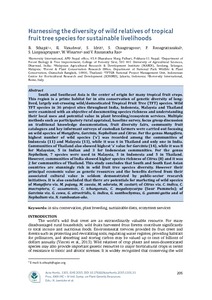Harnessing the diversity of wild relatives of tropical fruit tree species for sustainable livelihoods
South and Southeast Asia is the center of origin for many tropical fruit crops. This region is a prime habitat for in situ conservation of genetic diversity of long-lived, largely out-crossing wild/domesticated Tropical Fruit Tree (TFT) species. Wild TFT species in 36 project sites throughout India, Indonesia, Malaysia and Thailand were examined with an objective of documenting species richness and understanding their local uses and potential value in plant breeding/ecosystem services. Multiple methods such as participatory rural appraisal, baseline survey, focus group discussion on traditional knowledge documentation, fruit diversity fairs, community fruit catalogues and key informant surveys of custodian farmers were carried out focusing on wild species of Mangifera, Garcinia, Nephelium and Citrus. For the genus Mangifera, highest number of wild species (LSQUOsRSQUO) was recorded among the communities of Indonesia (11) and Malaysia (11), while it was 6 in Thailand and only one in India. Communities of Thailand also showed highest LSQUOsRSQUO value for Garcinia (14), while it was 8 for Malaysian, 5 in Indian and 3 for Indonesian communities. For the genus Nephelium, 7 species were used in Malaysia, 5 in Indonesia and 5 in Thailand. However, communities of India showed higher species richness of Citrus (8) and it was 2 for communities of Thailand. This study concludes that South and South East Asian countries are stunningly rich in wild fruit tree species diversity. However their principal economic value as genetic resources and the benefits derived from their associated cultural value is seldom demonstrated by public-sector research initiatives. It is also concluded that there are potentials for marketing of wild species of Mangifera viz. M. pajang, M. caesia, M. odorata, M. casturi; of Citrus viz. C. indica, C. macroptera, C. assamensis, C. ichangensis, C. megaloxycarpa (Sour Pummelo); of Garcinia viz. G. cowa, G. atroviridis, G. indica, G. xanthochymus, G. gummi-gutta and of Nephalium viz. N. ramboutan-ake.

